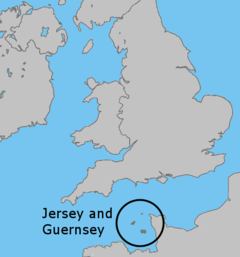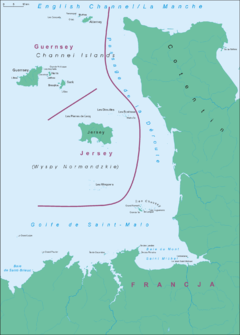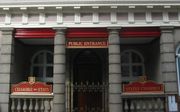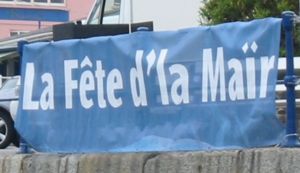Channel Islands
2008/9 Schools Wikipedia Selection. Related subjects: Geography of Great Britain
The Channel Islands ( Norman: Îles d'la Manche, French: Îles Anglo-Normandes or Îles de la Manche) are a group of islands in the English Channel, off the French coast of Normandy. They comprise two separate bailiwicks: the Bailiwick of Guernsey and the Bailiwick of Jersey, both British Crown dependencies, and have a total population of about 160,000. The respective capitals, St. Peter Port and St. Helier have populations of 16,488 and 28,310. The Channel Islands are not part of the UK.
Geography
The inhabited islands of the Channel Islands are Jersey, Guernsey, Alderney, Sark, Herm (the main islands); Jethou, Brecqhou (Brechou), and Lihou. All of these except Jersey are in the Bailiwick of Guernsey, but the Minquiers, Écréhous, Les Dirouilles and Les Pierres de Lecq (the Paternosters), uninhabited groups of islets, are part of the Bailiwick of Jersey. Burhou and the Casquets lie off Alderney. As a general rule, the larger islands have the -ey suffix, and the smaller ones have the -hou suffix; this is believed to be from the Old Norse ey and holmr, respectively.
The Chausey Islands south of Jersey are not generally included in the geographical definition of the Channel Islands but occasionally described as 'French Channel Islands' in English in view of their French jurisdiction. They were historically linked to the Duchy of Normandy, but they are part of the French territory along with continental Normandy, and not part of the British Isles or of the Channel Islands in a political sense. They are an incorporated part of the commune of Granville ( Manche), and although popular with visitors from France, they are rarely visited by Channel Islanders, as there are no direct transport links from the other islands.
In official Channel Island French (see Jersey Legal French), the islands are called 'Îles de la Manche', while in France, the term 'Îles anglo-normandes' (Anglo-Norman isles) is used to refer to the British 'Channel Islands' in contrast to other islands in the Channel. Chausey is referred to as an 'Île normande' (as opposed to anglo-normande). 'Îles Normandes' and 'Archipel Normand' have also, historically, been used in Channel Island French to refer to the islands as a whole.
The very large tidal variation provides an environmentally rich inter-tidal zone around the islands, and some sites have received Ramsar Convention designation (see Category:Ramsar sites in the Channel Islands).
The waters around the islands include the following:
- The Swinge (between Alderney and Burhou)
- The Little Swinge (between Burhou and Les Nannels)
- La Déroute (between Jersey and Sark, and Jersey and the Cotentin)
- Le Raz Blanchard, or Race of Alderney (between Alderney and the Cotentin)
- The Great Russel (between Sark, Jéthou and Herm)
- The Little Russel (between Guernsey, Herm and Jéthou)
- Souachehouais (between Le Rigdon and L'Étacq, Jersey)
- Le Gouliot (between Sark and Brecqhou)
- La Percée (between Herm and Jéthou)
History
The islands were annexed to the Duchy of Normandy in 933. In 1066, William II of Normandy, a vassal to the king of France, invaded and conquered England, becoming William I of England, also known as William the Conqueror. Since 1204, the loss of the rest of the monarch's lands in mainland Normandy has meant that the Channel Islands have been governed as separate possessions of the Crown.
The Bailiwicks have been administered separately from each other since the late 13th century, and although those unacquainted with the islands often assume they form one political unit, common institutions are the exception rather than the rule. The two Bailiwicks have no common laws, no common elections, and no common representative body (although their politicians consult regularly). There is no common newspaper or radio station, but a common television station, ITV Channel Television.
The islands acquired commercial and political interests in the North American colonies. Islanders became involved with the Newfoundland fisheries in the 17th century. In recognition for all the help given to him during his exile in Jersey in the 1640s, Charles II gave George Carteret, Bailiff and governor, a large grant of land in the American colonies, which he promptly named New Jersey, now part of the United States of America. Edmund Andros of Guernsey was an early colonial governor in North America, and head of the short-lived Dominion of New England.
Over a dozen windmills are known to have existed in the Channel Isles. They were mostly tower mills used for grinding corn.
During the Second World War, the islands were the only part of the British Commonwealth occupied by Germany. The German occupation 1940–1945 was harsh, with some island residents being taken for slave labour on the continent; native Jews sent to concentration camps; partisan resistance and retribution; accusations of collaboration; and slave labour (primarily Russians and eastern Europeans) being brought to the islands to build fortifications. The Royal Navy blockaded the islands from time to time, particularly following the liberation of mainland Normandy in 1944. Intense negotiations resulted in some Red Cross humanitarian aid, but there was considerable hunger and privation during the five years of German occupation, particularly in the final months when the population was close to starvation. The German troops on the islands surrendered only a few days after the final surrender in mainland Europe.
Politics
The Channel Islands fall into two separate self-governing bailiwicks. Both the Bailiwick of Guernsey and the Bailiwick of Jersey are British Crown Dependencies, but neither is part of the United Kingdom. They have been part of the Duchy of Normandy since the 10th century and Queen Elizabeth II is often referred to by her traditional and conventional title of Duke of Normandy. However, pursuant to the Treaty of Paris (1259) she is not the Duke in a constitutional capacity and instead governs in her right as Queen. This notwithstanding, it is a matter of local pride by monarchists to treat the situation otherwise; the Loyal Toast at formal dinners is to 'The Queen, our Duke', rather than 'Her Majesty, the Queen' as in the UK.
The Channel Islands are not represented in the UK Parliament and each island has its own primary legislature, known as the States of Guernsey and the States of Jersey, with Chief Pleas in Sark and the States of Alderney. Laws passed by the States are given Royal Sanction by the Queen in Council, to which the islands' governments are responsible.
The systems of government date from Norman times, which accounts for the names of the legislatures, the States, derived from the Norman 'États' or ' estates' (i.e. the Crown, the Church, and the people). The States have evolved over the centuries into democratic parliaments.
A bailiwick is a territory administered by a bailiff. The Bailiff in each bailiwick is the civil head, presiding officer of the States, and also head of the judiciary.
In 2001, responsibility for links between the Channel Islands (together with the Isle of Man) and the Crown passed from the Home Secretary to the Lord Chancellor's Department, replaced in 2003 by the Department of Constitutional Affairs.
In addition, Acts of the UK Parliament may be extended to any of the Channel Islands by Order-in-Council (thus giving the UK Government the ultimate responsibility for good governance in the islands). By constitutional convention this is only done at the request of the Insular Authorities, and has become a rare option, the islands usually preferring nowadays to pass localised versions of laws giving effect to international treaties.
Matters reserved to the Crown (i.e. the United Kingdom Government) are limited to defence, citizenship, and diplomatic representation. The islands are not bound by treaties concluded by the United Kingdom (unless they so request) and may separately conclude treaties with foreign governments (except concerning matters reserved to the Crown). The United Kingdom conceded at the end of the 20th century that the islands may establish direct political (non-diplomatic) contacts with foreign governments to avoid the situation whereby British embassies were obliged to pass on communications from the governments of the Bailiwicks that were in conflict with United Kingdom government policy.
The islands are not part of the European Union, but are part of the Customs Territory of the European Community, by virtue of Protocol Three to the Treaty on European Union.
Islanders are full British citizens, but not all are European citizens. Any British citizen who applies for a passport in Jersey or Guernsey receives a passport bearing the words ' British Islands, Bailiwick of Jersey' or 'British Islands, Bailiwick of Guernsey'. Under the provisions of Protocol Three, Channel Islanders who do not have a close connection with the UK (no parent or grandparent from the UK, and have never been resident in Great Britain or Northern Ireland for any five-year period) do not automatically benefit from the EU provisions on free movement within the EU and consequently their passports receive an endorsement to that effect. This only affects a minority of islanders.
Under the Interpretation Act 1978, the Channel Islands are deemed to be part of the British Islands, not to be confused with the British Isles.
Both Bailiwicks are members of the British-Irish Council, and Jèrriais and Dgèrnésiais are recognised regional languages of the Isles.
The legal courts are separate (separate courts of appeal have been in place since 1961). Among the legal heritage from Norman law is the Clameur de Haro.
Economy
Tourism is the major industry in the smaller islands (with some agriculture). Jersey and Guernsey have, since the 1960s, relied on financial services. Guernsey's horticultural and glasshouse activities have been more significant than in Jersey, and Guernsey has maintained light industry as a higher proportion of its economy than Jersey. Jersey's economy since the 1980s has been substantially more reliant on finance.
Both Bailiwicks issue their own banknotes and coins, which circulate freely in all the islands alongside UK coinage and Bank of England and Scottish banknotes.
Transport and communications
Since 1969, Jersey and Guernsey have operated postal administrations independently of the UK's Royal Mail, with their own postage stamps, which can only be used for postage in their respective Bailiwicks. UK stamps are no longer valid, but mail to the islands, and to the Isle of Man, is still treated as UK inland. However, it was not until the early 1990s that the islands joined the UK's postcode system, Jersey postcodes using the initials JE and Guernsey using GY.
The islands are connected to the radio and television system of the UK. They are part BBC South West, with two local BBC radio stations, BBC Radio Guernsey and BBC Radio Jersey, but takes BBC television from the Westcountry. It does have its own ITV franchise, Channel Television, which it has held since September 1962. Because it is not part of the United Kingdom, it is not listed as part of the digital switchover, but it is expected to change in 2013, after the rest of the UK has completed the switchover.
Jersey always operated its own telephone services independently of the UK's General Post Office, but Guernsey did not establish its own telephone services until 1969. Both islands still form part of the UK telephone numbering plan, but Ofcom in the UK does not have responsibility for regulatory and licensing issues on the islands.
The Channel Islands have their own country-code top-level-domains ( ccTLDs) on the internet, managed by a Network Information Centre in Alderney. The ccTLDs are .gg for the Bailiwick of Guernsey (including Alderney and Sark) and .je for the Bailiwick of Jersey. The codes were established on the Internet in 1996, and were entered on to the official ISO-3166 list of country codes in 2006.
Alderney has a large and growing internet gambling industry.
Each of the three largest islands has a distinct vehicle registration scheme:
- Guernsey (GBG)- simply a number, up to five digits;
- Jersey (GBJ) - J followed by up to seven digits (JSY vanity plates are also issued);
- Alderney (GBA) - AY followed by up to five digits (four digits are the most that have been used, as redundant numbers are re-issued).
In Sark - where most motor traffic is prohibited - the few vehicles (nearly all tractors) on the island do not display plates.
Names used for the cross-Channel ferries plying the mail route between the islands and Weymouth, Dorset (England), in the 1960s were taken from the popular Latin names for the islands 'Caesarea' for Jersey, 'Sarnia' for Guernsey, 'Riduna' for Alderney.
Culture
Culturally, the Norman language predominated in the islands until the 19th century, when increasing influence from English-speaking settlers and easier transport links led to Anglicisation. There are four main dialects/languages of Norman in the islands, Auregnais (Alderney, extinct in late 20th century), Dgèrnésiais (Guernsey), Jèrriais (Jersey) and Sarkese (Sark, an offshoot of Jèrriais).
Victor Hugo spent many years in exile, first in Jersey and then in Guernsey where he wrote Les Misérables. Guernsey is also the setting of Hugo's later novel, Les Travailleurs De La Mer ( The Toilers of the Sea). A 'Guernsey-man' also makes an appearance in Herman Melville's Moby-Dick.
The annual ' Muratti', the inter-island football match, is considered the sporting event of the year - although, thanks to broadcast coverage, it no longer attracts the crowds of spectators, travelling between the islands, that occurred during the 20th century.
Channel Island sportsmen and women compete in the Commonwealth Games for their respective islands, and the islands have been enthusiastic supporters of the Island Games. Shooting is a popular sport - islanders have won Commonwealth medals in this discipline.
Guernsey's traditional colour for sporting and other purposes is green and Jersey's is red.
The main islanders have traditional animal nicknames:
- Guernsey: les ânes ('donkeys' in French and Jèrriais) - the steepness of St. Peter Port streets required beasts of burden, but Guernsey people also claim it is a symbol of their strength of character - which Jersey people traditionally interpret as stubbornness.
- Jersey: crapauds ('toads' in French and Jèrriais) - Jersey has toads and snakes that Guernsey lacks.
- Sark: corbins ('crows' in Sercquiais, Dgèrnésiais and Jèrriais) - crows could be seen from sea on the island's coast.
- Alderney: lapins ('rabbits') - The island is noted for its warrens.
Christianity was brought to the islands around the 6th century; according to tradition, Jersey was evangelised by Saint Helier, Guernsey by Saint Samson of Dol and other smaller islands were occupied at various times by monastic communities representing strands of Celtic Christianity. At the Reformation, the islands turned Calvinist under the influence of an influx of French-language pamphlets published in Geneva. Anglicanism was imposed in the 17th century, but the Non-Conformist tendency re-emerged with a strong adoption of Methodism. The presence of long-term Catholic communities from France and seasonal workers from Brittany and Normandy added to the mix of denominations among the population.
Other islands in the English Channel
There are other islands in other stretches of the English Channel that are not traditionally included within the grouping of Channel Islands. Among these are Ouessant/Ushant, Bréhat, Île de Batz, and Îles Saint-Marcouf (under French jurisdiction), and the Isle of Wight and the Isles of Scilly (both under UK jurisdiction and part of England).
| Find more about Channel Islands on Wikipedia's sister projects: | |
|---|---|
| |
Dictionary definitions |
| |
Textbooks |
| |
Quotations |
| |
Source texts |
| |
Images and media |
| |
News stories |
| |
Learning resources |





